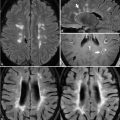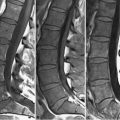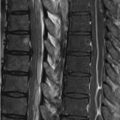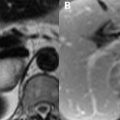41 Congenital Abnormalities Several congenital conditions affect the lumbar spine. Caudal regression refers to the absence of sacrococcygeal vertebrae with or without lumbar involvement. The typical appearance is illustrated in Fig. 41.1: on this sagittal T1WI portions of the sacrum are clearly absent and the conus demonstrates a wedge or hatchet-shaped terminal portion. Two groups have been described depending on whether the conus terminates rostrally (group 1) or caudally (group 2) to the inferior portion of L1, the latter exhibiting more frequent neurologic dysfunction. An abnormally low-positioned conus is referred to as a tethered cord, an entity with many additional (and more common) causes. These include a tight filum terminale, an intradural lumbosacral lipoma, and diastematomyelia. The typical tethered cord patient presents with progressive neurologic dysfunction. As such, most lesions are repaired at birth, but retethering may occur, as was the case of the lesion illustrated in Figs. 41.2A,B. Here, two adjacent sagittal T2WI demonstrate a retethered cord: the cord gradually tapers until reaching the end of the thecal sac without a distinctly identifiable conus—a typical appearance. Whenever a tethered cord is present, a reason for the tethering must be sought out. In this case a concomitant type 2 Chiari malformation (see Chapter 25) is to blame, demonstrating classic tectal beaking as well as partial callosal agenesis on the sagittal T1WI of Fig. 41.2C
![]()
Stay updated, free articles. Join our Telegram channel

Full access? Get Clinical Tree








